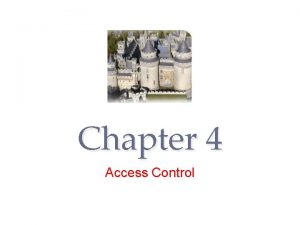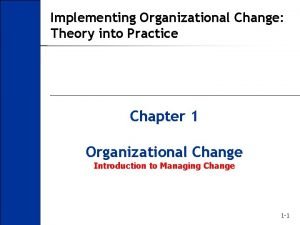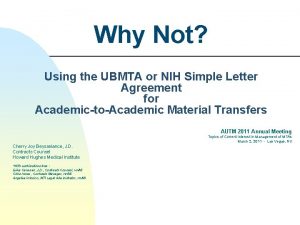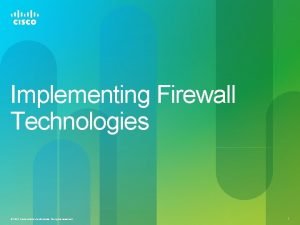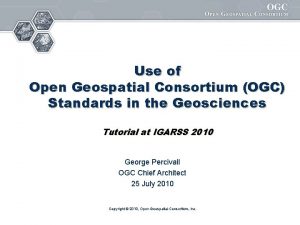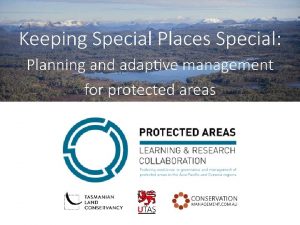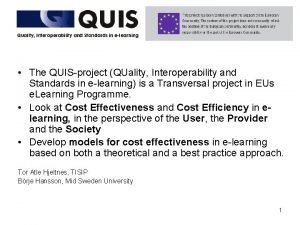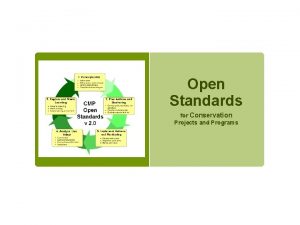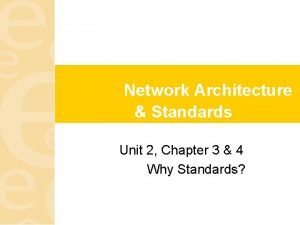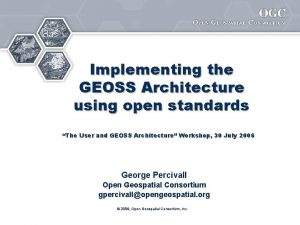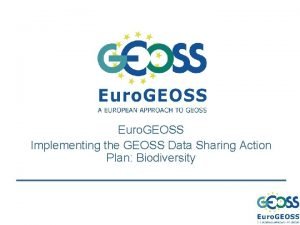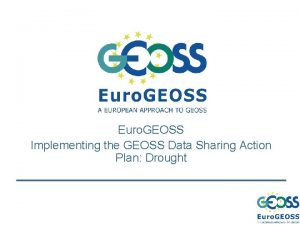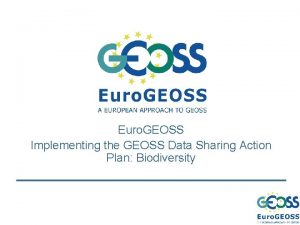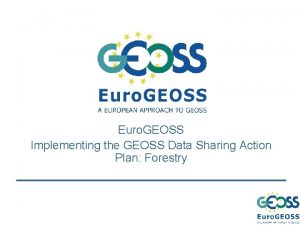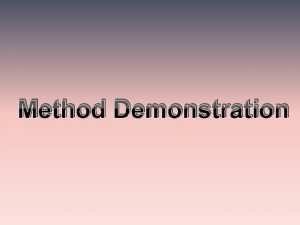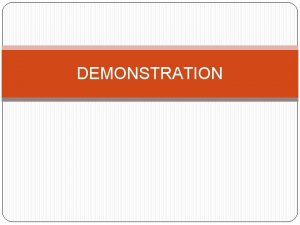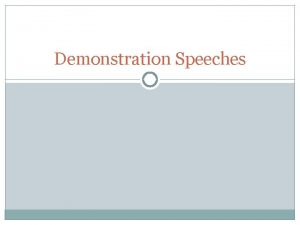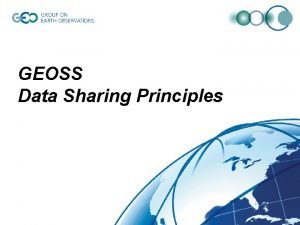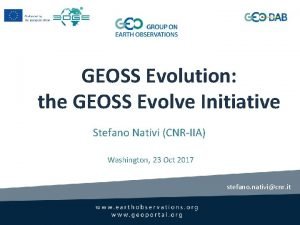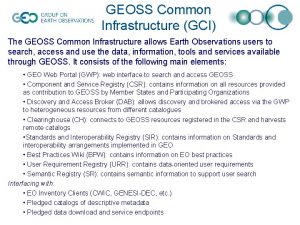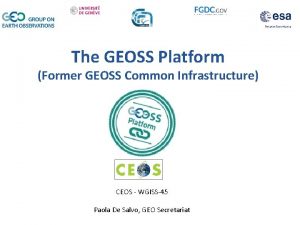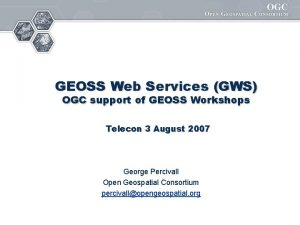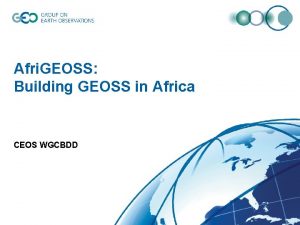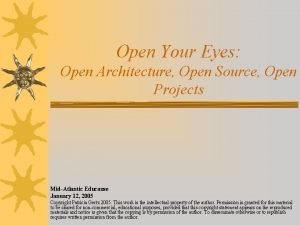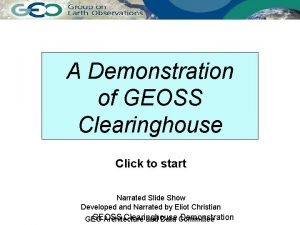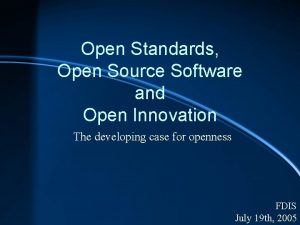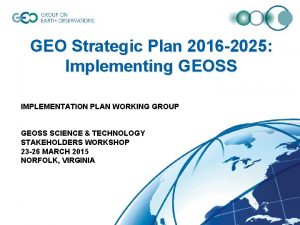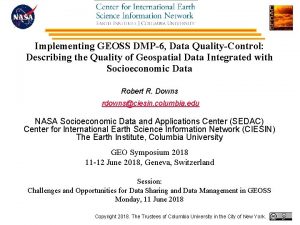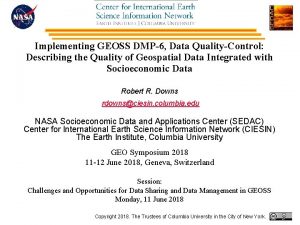Concept Demonstration Implementing GEOSS Architecture using open standards

































- Slides: 33

Concept Demonstration: Implementing GEOSS Architecture using open standards “The User and GEOSS Architecture” Workshop, 24 July 2005 George Percivall OGC Executive Director, Interoperability Architecture percivall@opengeospatial. org +1 301 -560 -6439 © 2005, Open Geospatial Consortium, Inc.

What is OGC? • Open Geospatial Consortium (OGC) – Not-for-profit, international voluntary consensus standards organization – 270+ industry, government, and university members – Founded in 1994, with 8 Charter members Mission To lead the global development, promotion and harmonization of open standards and architectures that enable the integration of geospatial data and services into user applications and advance the formation of related market opportunities. © 2005, Open Geospatial Consortium, Inc. Helping the World to Communicate Geographically 2

Approved Open. GIS® Specifications • Tightly coupled: – Simple Feature Access – OLE, SQL, CORBA – Grid Coverages 1. 0 – GO-1 Application Objects • Focus on Web Services Available free of charge at www. opengeospatial. org (Documents) Ø Catalog 2. 0 Ø Coordinate Transformation 1. 1 Ø Web Map Service (WMS 1. 3) Ø Web Feature Service (WFS 1. 0) Ø Filter Encoding 1. 0 Ø Geography Markup Language 3. 0 (GML) Ø Style Layer Descriptors 1. 0 Ø Web Coverage Service 1. 0 Ø Web Map Context 1. 0 Ø OGC Web Services Common Ø Open Location Service Specification Set 1. 0 © 2005, Open Geospatial Consortium, Inc. Helping the World to Communicate Geographically 3

OGC Impact on Geospatial & Location Based Technologies • Several hundred products are implementing Open. GIS Specifications – See OGC “Registered Products” List under “Resources” at www. opengeospatial. org • Formal Compliance certification is increasing in importance © 2005, Open Geospatial Consortium, Inc. Helping the World to Communicate Geographically 4

OGC Web Services (OWS) • OGC testbeds develop candidate specifications – Testbeds have been very successful in developing web service specifications adopted by OGC members • OGC Web Services, Phase 2 (OWS-2) testbed – Implemented GEOSS Architecture; completed September ‘ 04 – “Image Handling for Decision Support” • OWS-2 components retasked for GEOSS Workshop – OWS-2 demo was Wildfire Management – Demo today will access and process remote sensed data related to Indian Ocean Tsunami – Retasking accomplished in 3 weeks, 3 telecons © 2005, Open Geospatial Consortium, Inc. Helping the World to Communicate Geographically 5

OWS-2 sponsor direction Data © 2005, Open Geospatial Consortium, Inc. Helping the World to Communicate Geographically 6

OWS-2 Components Future access via Open. GIS Interfaces Standards & Interoperability Data WMS WFS WCS ECHO Clients, Catalogs & Workflow Access via Open. GIS Interfaces Geospatial Processing Services © 2005, Open Geospatial Consortium, Inc. Helping the World to Communicate Geographically 7

Access to Data using OGC Web Services Web Coverage Service Web Feature Service Web Map Service Web Terrain Service © 2005, Open Geospatial Consortium, Inc. Helping the World to Communicate Geographically 8

OWS-2 Geospatial Processing Services • Web Image Classification Service (WICS) – Implements joint OGC/GRSS Paper, Percivall and Smits, 2001 – Implemented in OWS-2 by George Mason University • Un-supervised classification was demonstrated • Supervised classification discussed in report • Web Coordinate Transformation Service (WCTS) – Implements ISO 19111, Geographic Information - Spatial Referencing by Coordinates – Implemented in OWS-2 by PCI Geomatics • Map projection • Orthorectification using a DEM • Publicly available as OGC Discussion Papers © 2005, Open Geospatial Consortium, Inc. Helping the World to Communicate Geographically 9

“Chaining” Web Services For Decision Support Assess Wildfire Activity Demonstrated in 2004 as part of OGC Web Services Testbed OGC Interfaces Service chaining creates Value-added products Internet Decision Support Client WCS WCTS WICS (NASA & Spot) (Producer-B, Vendor-2) (Producer-C, Vendor-3) WFS (Producer-n, Vendor-x) … Web Servers © 2005, Open Geospatial Consortium, Inc. Helping the World to Communicate Geographically 10

OGC Response to GEO • OGC is a participating member of GEO • OGC goals consistent with GEOSS 10 -Year Implementation Plan – “GEOSS interoperability will be based on non-proprietary standards – “GEO will establish, within 2 years, a process for reaching, maintaining, and upgrading GEOSS interoperability arrangements, informed by ongoing dialogue with major international programs and consortia. ” • OGC developing plan for GEOSS Interoperability Initiatives – Conduct Constituency building workshops – Develop OGC Technology Strategy for GEOSS – Develop OGC-GEOSS Testbed Concepts © 2005, Open Geospatial Consortium, Inc. Helping the World to Communicate Geographically 11

OGC Demonstration Participants • OGC members that supported the demonstration: – Boeing S&IS Mission Systems – DM Solutions Group – ESA (Spacebel, contractor to ESA) – George Mason University (GMU) – Intergraph – NASA – PCI Geomatics – Raytheon – Spot Image – USGS © 2005, Open Geospatial Consortium, Inc. Helping the World to Communicate Geographically 12

Demo Script • This scenario describes analysis and decision support tasks for post. Tsunami assessment of existing data and by creating new information about the Tsunami in the Indian Ocean on December 26, 2004 1. Review CAP message for Tsunami to begin analysis – Display GML polygon from CAP message – Display CAP text as GML Feature Information 2. Review available Tsunami data via WMS and WCS – WMS layers provided by Asian Institute of Technology (AIT), Chulalongkorn Univ. , Osaka City Univ. , Univ. of Ottawa, DM Solutions – Access to SPOT 5 images using WCS 3. Create new image product by chaining processing services – ESA, Spot Image, PCI Geomatics WCTS, GMU © 2005, Open Geospatial Consortium, Inc. Helping the World to Communicate Geographically 13

1. Review CAP message for Tsunami Clients ESA Workflow Services Intergraph GMU Wf. CS ESA SSE, GMU BPEL Power Processing Services WICS GMU Data Services WCS NASA/Raytheon • MODIS • ASTER WCTS GMU PCI WCS GMU • AIRDAS • MODIS • Landsat Spot Image/Ionic • SPOT HLS WMS WFS Mapsherpa/ DM Solutions NASA JPL • Landsat Global Mosaic Intergraph • CAP © 2005, Open Geospatial Consortium, Inc. Helping the World to Communicate Geographically 14

2. Review available data via WMS and WCS Clients ESA Workflow Services Intergraph GMU Wf. CS ESA SSE, GMU BPEL Power Processing Services WICS GMU Data Services WCS NASA/Raytheon • MODIS • ASTER WCTS GMU PCI WCS GMU • AIRDAS • MODIS • Landsat Spot Image/Ionic • SPOT HLS WMS WFS Mapsherpa/ DM Solutions NASA JPL • Landsat Global Mosaic Intergraph • CAP © 2005, Open Geospatial Consortium, Inc. Helping the World to Communicate Geographically 15

SPOT Images used for OGC demo • Two SPOT 5 images over Andaman Island – Image acquired before Tsunami Image Corner Geographic Localisation NW 92° 21' E / 11° 51' N SE 92° 50' E / 11° 11' N • Date 2004 -02 -25 • Mode – Multispectral (Green, Red, NIR) • Resolution – 10 meters • Size 6000*6000 pixels (Raw level) – Image acquired after Tsunami • Date 2004 -12 -28 • Mode Image Corner Geographic Localisation NW 92° 16' E / 11° 59' N SE 92° 42' E / 11° 19' N – Multispectral (Green, Red, NIR) • Resolution – 5 meters • Size 12000*12000 pixels (Raw level) © 2005, Open Geospatial Consortium, Inc. Helping the World to Communicate Geographically 16

3. New image by chain of processing services Clients ESA Workflow Services Intergraph GMU Wf. CS ESA SSE, GMU BPEL Power Processing Services WICS GMU Data Services WCS NASA/Raytheon • MODIS • ASTER WCTS GMU WCS PCI WCS GMU • AIRDAS • MODIS • Landsat Spot Image/Ionic • SPOT HLS • SPOT DEM WMS WFS Mapsherpa/ DM Solutions NASA JPL • Landsat Global Mosaic Intergraph • CAP © 2005, Open Geospatial Consortium, Inc. Helping the World to Communicate Geographically 17

OGC Demonstration of GEOSS Architecture • This demonstration will show that – Earth Observations data and information is available now, through open standard mechanisms highlighted in the GEOSS 10 Year Implementation Plan and Reference Document – The geospatial community implementation of OGC specifications provides a broad based capability to implement GEOSS © 2005, Open Geospatial Consortium, Inc. Helping the World to Communicate Geographically 19

Back-up Slides © 2005, Open Geospatial Consortium, Inc.

OGC Today • 280 members worldwide – 31 countries & 5 continents – 100 European members – 34 Asia-Pacific members • 90+ Academic and Research Members • 16 approved, publicly available Implementation Specifications fielded in hundreds of products • 20+ candidate Implementation Specifications in work • Significant interaction with ISO and many other standards organizations © 2005, Open Geospatial Consortium, Inc. Helping the World to Communicate Geographically 21

OGC’s Approach for Advancing Interoperability • Interoperability Program (IP) - a global, innovative, hands-on prototyping and testing program designed to accelerate interface development and validation, and bring interoperability to the market Rapid Interface Development • Specification Development Program –Consensus processes similar to other Industry consortia (World Wide Web Consortium, OMA, OMG, etc. ). • Outreach and Community Adoption Program – education and training, encourage take up of OGC specifications, business development, communications programs © 2005, Open Geospatial Consortium, Inc. Standards Setting Market Adoption Helping the World to Communicate Geographically 22

OGC Web Services Architecture Overview • OGC Technologies provide a Web and Location Based Services environment where: – Resource providers can advertise their resources (publish) – End users can discover resources that they need at run-time (find) – End users and their applications can access and exercise resources at run-time (bind) • This requires: – A forum where resources can advertise their capabilities and users can find the resources they need. – Self describing resources so that user applications can bind at runtime to the resources that they have found. © 2005, Open Geospatial Consortium, Inc. Helping the World to Communicate Geographically 23

OGC Tiered Services Architecture © 2005, Open Geospatial Consortium, Inc. Helping the World to Communicate Geographically 24

Publishing and Discovery • Catalogs leverage ISO conformant metadata • Support publishing and discovery of distributed geospatial data and associated services OGC Catalog Service 2. 0 ISO 19115 Data Metadata Standard ISO 19119 Service Metadata Standard © 2005, Open Geospatial Consortium, Inc. Helping the World to Communicate Geographically 25

Geography Markup Language: Representing Geographic Features Another Information Community’s Schema Highway is: _Pavement thickness _Right of way _Width …. One Information Community’s Schema Road is: _Width _Lanes _Pavement type …. Cell tower is: _Owner _Height _Licensees …. Cell transm. Platform is: _Location _No. of antennas _Elevation GML 3. 0 Support for complex geometries, spatial and temporal reference systems, topology, units of measure, metadata, feature and coverage visualization. Backward compatible …. Mayberry’s Cell Tower (an instance of Cell Transm. Platform in another IC’s schema) Mayberry Road (an instance of Road in one IC’s schema) GML defines a data encoding in XML that allows geographic data and its attributes to be moved between disparate systems Version 3. 0 advances interoperability on all fronts!! © 2005, Open Geospatial Consortium, Inc. Helping the World to Communicate Geographically 26

Sensor Web Enablement - Operations Concept Heterogeneous sensor network Airborne In-Situ monitors Surveillance - sparse - disparate Decision Support Tools Satellite Bio/Chem/Rad Detectors - mobile/in-situ - extensible Models and Simulations SWE Standards focus: - Discovery - Access - Tasking - Integration - Alert / Notification Based on: (OGC, ISO, OASIS, IEEE) - nested - national, regional, urban - adaptable - data assimilation - vendor neutral - extensive Source: Dr. Mike Botts -2004 © 2005, Open Geospatial Consortium, Inc. - flexible - adaptable Helping the World to Communicate Geographically 27

GALEON interoperability experiment • Implement geo-interface to net. CDF datasets via OGC WCS – Atmospheric and oceanographic sciences communities – Leverage base of OPe. NDAP and accompanying THREDDS servers – Initial experiments with numerical forecast model output • Initiators – – Unidata/UCAR - lead NASA IMAA-CNR George Mason University • Participants and observers – – – Cad. Corp University of Alabama Huntsville Jet Propulsion Laboratory University of Florence Interactive Instruments ESRI University of Applied Sciences. NERC/CCLRC Texas A&M University Research System International UK Ltd © 2005, Open Geospatial Consortium, Inc. Helping the World to Communicate Geographically 28

Spot Image Slides © 2005, Open Geospatial Consortium, Inc.

SPOT Image Characteristics © 2005, Open Geospatial Consortium, Inc. Helping the World to Communicate Geographically 30

SPOT swath with other systems Quick. Bird Ikonos 16. 5 x 16. 5 Km 11 x 11 Km Eros 1 A Spot 12. 5 X 12. 5 Km 60 x 60 Km © 2005, Open Geospatial Consortium, Inc. Helping the World to Communicate Geographically 31

SPOT Images acquired after Tsunami • The SPOT satellites sprang into action in Southeast Asia, acquiring 7, 906 images in less than three weeks. – Coverage from 26 December 2004 to 14 January 2005. © 2005, Open Geospatial Consortium, Inc. Helping the World to Communicate Geographically 32

Zoom on affected area • Before Tsunami – • Date 2004 -02 -25 After Tsunami – Date 2004 -12 -28 • Cartographic Coordinates • Upper Left corner – 462416, 1287556 Lower Right corner – 471406, 1281216 • • Projection – • UTM, Zone 46 Spheroid – WGS 84 Affected area Flooded area © 2005, Open Geospatial Consortium, Inc. Helping the World to Communicate Geographically 33

SPOT Product Geometric Level Used for Tsunami • Raw level directly from satellite – Radiometric corrections of distortions due to difference in sensitivity of the elementary detectors of the viewing instrument – Intended for users who wish to do their own geometric image processing • Ortho level processed on the Ground Station – Radiometric corrections (identical to raw level) – Map-projected product (default projection is UTM WGS 84) – Possibility to combine the image with geographical information of various types (vectors, raster maps and other satellite images) © 2005, Open Geospatial Consortium, Inc. Helping the World to Communicate Geographically 34
 Designing and implementing brand marketing programs
Designing and implementing brand marketing programs Designing and implementing brand architecture strategies
Designing and implementing brand architecture strategies Designing and implementing brand marketing programs
Designing and implementing brand marketing programs Open innovation open science open to the world
Open innovation open science open to the world Factors necessary for appropriate service standards
Factors necessary for appropriate service standards Hrd program implementation
Hrd program implementation Implementing strategies management and operations issues
Implementing strategies management and operations issues Implementing strategies management and operations issues
Implementing strategies management and operations issues Chapter 7 strategic management
Chapter 7 strategic management Tripod pricing strategy
Tripod pricing strategy Retail management notes doc
Retail management notes doc Portfolio assessment matches assessment to teaching
Portfolio assessment matches assessment to teaching Crm project plan
Crm project plan Qsen competencies
Qsen competencies Challenges of implementing predictive analytics
Challenges of implementing predictive analytics Implementing organizational change spector
Implementing organizational change spector Mis issues in strategy implementation
Mis issues in strategy implementation Is the traditional method of implementing access control
Is the traditional method of implementing access control Problems in implementing portfolio management
Problems in implementing portfolio management Strategic business unit structure
Strategic business unit structure Nfpa 1600 standard
Nfpa 1600 standard Implementing organizational change theory into practice
Implementing organizational change theory into practice Autm ubmta
Autm ubmta Implementing nfpa 1600 national preparedness standard
Implementing nfpa 1600 national preparedness standard Zpf cisco
Zpf cisco Ch 7
Ch 7 Open geospatial consortium standards
Open geospatial consortium standards Open standards for the practice of conservation
Open standards for the practice of conservation Open standards elearning
Open standards elearning Open standards conservation
Open standards conservation Network architecture standards
Network architecture standards Real self ideal self
Real self ideal self Perbedaan pemasaran dan penjualan
Perbedaan pemasaran dan penjualan Demonstration effect in tourism example
Demonstration effect in tourism example

















